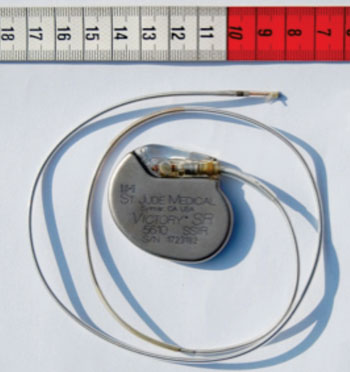Gene Therapy Induces Functional Pacemaker Cells in Pig Heart Failure Model
By LabMedica International staff writers
Posted on 30 Jul 2014
Cardiovascular disease researchers working with a porcine heart failure model have demonstrated the practicality of using gene therapy to replace implanted electronic pacemakers to regulate heartbeat.Posted on 30 Jul 2014
Investigators at Cedars-Sinai Heart Institute (Los Angeles, CA, US) examined whether adenoviral-TBX18 gene transfer could create biological pacemaker activity in vivo in a large-animal model of complete heart block. The Tbx18 gene is required for development of pacemaker cells in the heart during fetal development but is normally not functional after birth.

Image: This type of electronic pacemaker could become obsolete if induction of biological pacemaker cells by gene therapy proves successful (Photo courtesy of Wikimedia Commons).
Tbx18 gene therapy is aimed at treating a group of arrhythmias known as sick sinus syndrome. In a healthy heart, sinoatrial (SA) nodal cells act as the heart’s pacemaker and cause the heart to beat in a regular rhythm. While SA nodal cells comprise only about 10 thousand of the 10 billion cells in the heart, they play a crucial role in the heart’s function. In sick sinus syndrome the SA node does not function properly and causes irregular heartbeat. Currently the treatment for sick sinus syndrome is to remove the SA nodal cells that are not functioning properly and to implant an electronic pacemaker to maintain a regular rhythm. However, currently used electronic pacemakers have drawbacks such as equipment malfunction, limited battery life, lack of nervous system regulation, and risks associated with implantation of the device in one’s chest.
The investigators reported in the July 16, 2014, online edition of the journal Science Translational Medicine that functional SA nodal cells, which could be identified by their distinctive morphology, were found at the site of adenovirus-TBX18 injection shortly after intramyocardial injection of the material. Biological pacemaker activity was evident in the TBX18-transduced animals starting at day two and persisted for the duration of the study (14 days) with minimal backup electronic pacemaker use. No local or systemic safety concerns arose during the course of the study.
“We have been able, for the first time, to create a biological pacemaker using minimally invasive methods and to show that the biological pacemaker supports the demands of daily life,” said senior author Dr. Eduardo Marbán, director of the Cedars-Sinai Heart Institute. “We also are the first to reprogram a heart cell in a living animal in order to effectively cure a disease. Originally, we thought that biological pacemaker cells could be a temporary bridge therapy for patients who had an infection in the implanted pacemaker area. These results show us that with more research, we might be able to develop a long-lasting biological treatment for patients.”
The investigators hope that continued success with animal studies will lead to human clinical trials in about three years.
Related Links:
Cedars-Sinai Heart Institute













